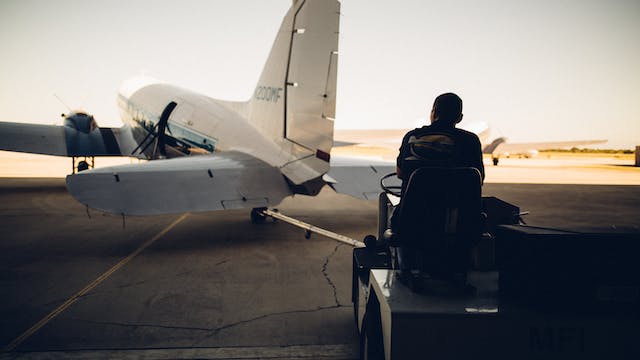12 Must-Have Tools for Every Aircraft Mechanic
An aircraft’s safety and dependability must be guaranteed by careful maintenance, and knowledgeable airplane technicians depend on a variety of specialized gear to do their jobs well. This thorough investigation delves further into twelve essential pieces of equipment that any airplane mechanic should keep in their toolbox.
1. Aviation Multimeter
The mechanic’s compass in the complex world of aircraft electronics is the aviation multimeter. With the accuracy of voltage, current, resistance, and continuity readings provided by this tool, one can diagnose electrical problems and guarantee the integrity of avionic systems. The aviation multimeter is a key component for troubleshooting as aircraft systems become more complicated, greatly enhancing flight safety and dependability.
2. Torque Wrench
Precise component fastening is essential for aviation maintenance. Bolts are tightened to precise specifications due to the precision tool known as the torque wrench. While under-tightening jeopardizes the integrity of vital components, overtightening can cause structural damage. Because of its precise calibration, the torque wrench is essential to preserving an aircraft’s structural integrity.
3. Aircraft Jacks
Mechanics often need to access different parts underneath an airplane. Aircraft jacks give mechanics the required elevation, making it simple for them to inspect and repair the undercarriage. Because safety is of the utmost importance, these specialty lifting devices provide a firm platform that improves both the efficiency and safety of maintenance activities.
4. Safety Wire Pliers
The angels of safety for aircraft fasteners are safety wire pliers. Mechanics use safety wires to secure important fasteners and keep them from coming loose during flight vibrations. The accuracy provided by safety wire pliers guarantees a tight and snug fit, giving the parts of the aircraft an additional degree of protection.
5. Aircraft Power Unit
A silent hero on the ground is the power unit. During repair, this equipment gives the aircraft a dependable electrical power source, removing the requirement for onboard power. The use of an aircraft ground power unit guarantees that avionic systems can be checked and repaired without restrictions and improves the effectiveness of maintenance processes.
6. Pneumatic Rivet Gun
Aircraft structural work mainly relies on rivets, and the mechanic’s tool of choice for structural work is a pneumatic rivet gun. By making it easier to insert and remove rivets with accuracy and efficiency, this tool helps maintain the aircraft’s overall structural integrity. Consistent force application is ensured by the pneumatic system, leading to strong and secure couplings.
7. Aviation Snips
Precision cutting is frequently required for aircraft maintenance, particularly when working with sheet metal. Because of their precision and robust design, aviation snips let mechanics cut through a wide range of materials with ease. These snips are an essential tool for preserving the aircraft’s structural integrity, whether they are being used to shape panels or trim parts.
8. Aircraft Tug
An aviation tug is a workhorse for maneuvering airplanes in hangars or on the tarmac, which requires specific equipment. With the help of controlled towing offered by these strong trucks, mechanics can move airplanes without using the engines. Using an aircraft tug during ground handling procedures improves both operational efficiency and safety.
9. Hydraulic Mule
A hydraulic mule is an essential tool for testing and maintaining the hydraulic systems that are essential to aircraft functioning. With the use of this transportable hydraulic power unit, mechanics can efficiently diagnose and fix hydraulic components by simulating the aircraft’s hydraulic pressure. When it comes to guaranteeing the dependability of vital flight control systems, the hydraulic mule is an indispensable tool.
10. Aircraft Maintenance Platforms
Stable and safe platforms are necessary for accessing different parts of an aircraft, particularly the wings and tail. Aircraft maintenance platforms give mechanics the height they need to carry out checks and repairs. These robustly constructed, non-slip platforms are engineered for safety to support mechanics and their instruments at elevated heights.
11. Digital Calipers
Aircraft maintenance requires precise measurements, and digital calipers provide an advanced answer. With the use of these portable tools, mechanics can measure measurements precisely, which helps with component production and installation. In order to make sure that every component satisfies the precise requirements needed for safe and dependable aircraft operation, digital calipers are essential.
12. Borescope
A borescope makes it easier to inspect difficult-to-reach places inside an aircraft’s engines, avionics, or other parts. With the use of this optical instrument, mechanics can visually evaluate their work and detect problems like wear, corrosion, and damage from external objects. By improving diagnostic capabilities, the borescope makes preventative maintenance actions possible, improving safety and dependability.
Conclusion
The tools in an aircraft mechanic’s toolbox are more than just tools; they are entry points to dependability, accuracy, and safety. These instruments are the unsung heroes that keep flights safe and the skies free. They do anything from navigating the complexity of avionic systems to guaranteeing the structural integrity of an aircraft.






